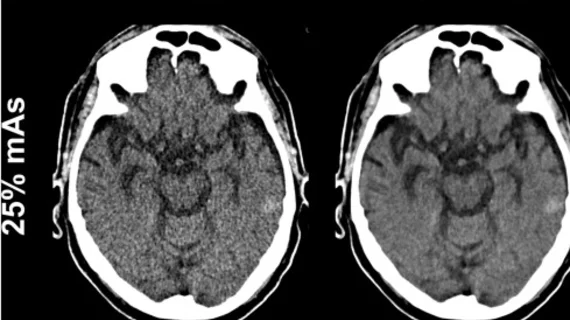Denoising algorithm produces quality trauma head CTs at a fraction of the radiation dose
Deep learning-based denoising techniques can provide high quality diagnostic neurological images at just a fraction of the radiation dose.
In fact, quality head CT scans in trauma settings can be reduced by as much as 75% with the help of denoising techniques with no impact to image quality, according to new research published this week in Academic Radiology.
“Modern artificial intelligence reconstruction algorithms have shown promise in reducing radiation dose while maintaining image quality,” Georg Gohla, MD, from the Department of Diagnostic and Interventional Neuroradiology at Eberhard Karls-University in Germany, and co-authors noted. “Therefore, we aimed to evaluate the dose reduction capabilities of a deep learning-based denoising (DLD) algorithm in traumatic neuroradiological emergency CT scans.”
Gohla and colleagues recently analyzed a set of 100 neurological trauma CT scans simulated at full (100%) and partial (25%) doses. The scans were processed using both iterative reconstruction and deep learning denoising using a commercially available algorithm. A group of neuroradiologists then conducted subjective and objective image quality assessments on the resultant exams.
The experts subjectively rated the imaging that had undergone denoising as superior, and they did not observe significant differences in image quality between the exams at both doses. Objective evaluations were similar, though raters noted slightly more noise in the denoised images at 25% of the standard dose.
At the lower dose, the denoising algorithm also yielded comparable sensitivity to iterative reconstruction for identifying fractures and hemorrhages, achieving endpoints necessary to ensure clinical utility, the group noted.
“Over the years, both patients and physicians have questioned the radiation exposure due to the increasing use of head CT in the neuroradiological emergency setting, and the carcinogenic long-term effects, especially for young patients, have been critically assessed,” the team wrote. “The findings of this study make a valuable contribution to the objective of dose reduction and underline the importance of research into dose-reduction techniques.”
The authors suggested that future studies should include readers with varying experience levels reading neurological trauma exams to determine whether the denoising algorithm would be as effective at lower doses when a less experienced provider is reviewing the study.
Learn more about the study here.

